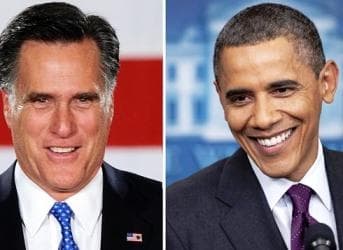When you read the Obama Blue Print for a Secure Energy Future and compare it to Romney’s Energy Plan for market-driven competitive energy growth to help advance the cause of energy independence, these two guys actually have opportunities for common ground that could make for a rational national energy strategy consensus as one outcome from this election.
Quit laughing!
I know what you are thinking! These guys are polar opposites. What makes you think they can find common ground? But if we could actually put some of these principles together from both strategies we actually might end up with something that would work.
The President’s 2011 Blue Print said:
“America produced more oil last year [2010] than we had in the last seven years. We’re taking steps to encourage more offshore oil exploration and production – as long as it’s safe and responsible. And, because we know we can’t just drill our way out of our energy challenge, we’re reducing our dependence on oil by increasing our production of natural gas and biofuels, and increasing our fuel efficiency. Last year, we announced ground-breaking fuel efficiency standards for cars and trucks that will save consumers thousands of dollars and conserve 1.8 billion barrels of oil.”
Governor Romney’s Energy Plan says:
“Empower states to control onshore energy development including on Federal lands; Open offshore areas for energy development; Pursue a North American Energy Partnership with Canada and Mexico; Ensure accurate assessment of energy resources; Restore transparency and fairness to permitting and regulation; and Facilitate private-sector-led development of new energy technologies.“
OK, step one what if we give President Obama credit for all the domestic energy production growth over the last four years that has taken place on private lands—96% of all growth. And we give him credit for holding off the regulatory hounds eager to thrash hydraulic fracturing. From the Romney plan, the President would compromise by supporting the Keystone XL pipeline and the rationalizing of our energy infrastructure to bring all that shale oil and gas to market. In addition, the President would agree to streamlining environmental regulation, permitting and development on Federal lands and giving the States a bigger role in the E&P growth potential in each state to achieve a goal of matching domestic oil and gas production growth on Federal lands with that on private lands.
This compromise action alone would fundamentally alter America’s energy future and help achieve the shared policy objective of energy independence. Achieving this goal this way does not abandon our environmental protection objectives or policies, but it would use Mitt Romney’s business savvy to strip the unnecessary process steps out of the regulatory process and prevent interveners from using the law to frustrate national policy. Congress can take some credit too by codifying the streamlined procedures into law to prevent back sliding.
See that was not so hard!
Step two, the Obama Administration gets credit for raising federal fuel efficiency standards, known as CAFE, to an average 35.5 mpg by 2016. Recently, they announced they are raising CAFÉ again for model year 2025, the average fuel economy for cars and light-duty trucks will be set at 54.5 mpg. This will mean a nearly doubling of fuel efficiency compared to cars that are on the road today. The US Department of Transportation (DOT) and Environmental Protection Agency (EPA) claim it will cut US oil consumption by 12 billion barrels and save over $1.7 trillion at the pump over the life of the program. So let’s give the President credit for pressing hard to improve fuel efficiency.
“These fuel standards represent the single most important step we’ve ever taken to reduce our dependence on foreign oil,” said President Obama. “This historic agreement builds on the progress we’ve already made to save families money at the pump and cut our oil consumption. By the middle of the next decade our cars will get nearly 55 miles per gallon, almost double what they get today. It’ll strengthen our nation’s energy security, it’s good for middle class families and it will help create an economy built to last.”
The quid pro quo in our hypothetical compromise is that the President will modify his ‘all of the above strategy’ for power generation to accept Mitt Romney’s market-based energy strategy of forcing fuels and technologies to compete for a place in the supply stack. This means calling off the EPA hounds and their war on coal and let coal and natural gas fight it out for the least cost, best fit place on the podium along with wind and solar and other renewable energy technologies. NOx and SOx regulations are retained and coal plants that lack scrubbers are required to install them. But CO2 emissions regulations are held in abeyance in the belief that the market will re-balance the share of coal and natural gas generation to achieve a substantial reduction in CO2 emissions from, burning clear natural gas for as long as natural gas prices stay low. But given the long lead time for permitting and building a coal power plant, if natural gas prices rise to the point coal is again competitive on the margin there will be plenty of time to reconsider the policy balance. In exchange, Governor Romney agrees to renew wind and solar production tax credits to 2025 but the President agrees to end loan guarantees, Treasury tax grants and his winners and losers strategy.
ADVERTISEMENT
There you have it, a compromise that advanced America’s energy and environmental goals, creates more policy and regulatory certainty, and facilities job growth and GDP growth in the economy with a low energy price foundation.
Is this a great country of what?!#$!
By. Gary L. Hunt

















